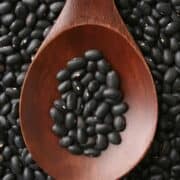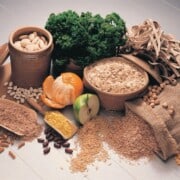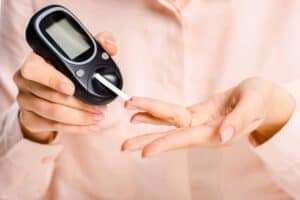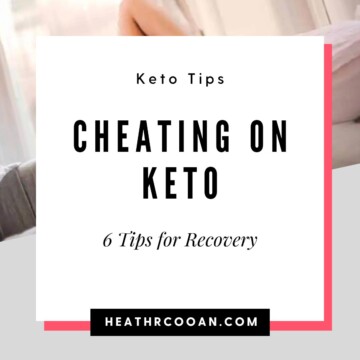
Ketosis signs and symptoms can tip you off as to whether or not you have entered into ketosis. So if you’ve been following a keto diet and you’re wondering how you will actually know that your body is in ketosis this post is for you. First, let’s back up a minute and get a quick overview of what ketosis is.
Ketosis is a metabolic state where your body converts fat into molecules called ketones. These ketones are then utilized by the body as the primary energy source in the absence of glucose. In order to push the body into ketosis, you must restrict the intake of carbohydrates to a significant point.
Typically, carbohydrates are the primary source of energy on a cellular level. When carbohydrates are reduced to less than 50g per day, insulin secretion reduces and the body enters a catabolic state. Glycogen, stored reserves of glucose in the body, begin to deplete and force a metabolic shift, which leads to ketosis. (1)
Am I There Yet?
How long it takes for the body to enter a state of ketosis varies between individuals for a variety of factors including differing metabolic rates, exercise, age, and daily intake of fat, protein and carbohydrates.
In general, it seems to take between 2-4 days when eating between 20-50g of total carbohydrates each day.
How Will I Know When I Get There?
Considering that it is a generalization, some people may find that it takes a week or even longer to push their body into ketosis. When shifting from a diet high in carbohydrates, it may take longer to enter ketosis as the body takes longer to deplete its glycogen stores. Knowing what to expect in terms of signs and symptoms is a good first step to understanding when you have reached ketosis. (1)
Your body will provide some clues to let you know that you are in ketosis. These can include:
The Keto Flu
Experiencing the keto flu, which is not an actual illness, but rather a constellation of symptoms that many people experience as their body shifts into ketosis. Symptoms include headaches, overall feelings of fatigue, mood swings and difficulty focusing.
An Initial Period of Weight Loss
In the first two weeks after your body enters ketosis, many people experience rapid weight loss as a result of the body shedding glycogen stores and retained water.
Sleep Disturbances
Insomnia can be a symptom that your body is going through the metabolic shift towards ketosis. While experienced initially by many people, most sleep disruptions resolve in a few weeks.
Decrease in Performance and Stamina
In terms of physical training, you may notice a dip in performance and less stamina overall when you begin to enter ketosis. Again, this is temporary and once resolved, you may experience a drastic improvement when it comes to both metrics.
Digestive Issues
As with many other dietary changes, the keto diet can initially cause digestive problems, any many people experience a combination of both constipation and diarrhea. These digestive difficulties may be due to an overall reduction in food volume, reduced fiber intake, increased fat intake or a mix of the three. (2) Though it can prove to be a nuisance, these symptoms also resolve quickly.
Bad Breath
Often called ‘keto breath’, once your body is in ketosis, metabolism of the ketones produces an acetone byproduct. These acetones often cause halitosis and can be smelled on the breath and in sweat. It is typically described as a fruity or maple syrup-type smell that is typically helped by using breath fresheners, deodorants or fragrant essential oils.
Many of these symptoms are thought to be the result of increased sodium and potassium being excreted through urine, and a higher output of urine in general, all of which are caused by lowered insulin levels. (2) These reactions are typically seen between days 1-4 when transitioning into ketosis.
Despite feeling one or more of the typical signs and symptoms of ketosis, it doesn’t mean with certainty that your body has entered this metabolic state. To be certain that you’re in ketosis, you could consider using ketone urine test strips. A fairly straightforward method of testing, these test strips are easy to use at home and come with a color guide that will help you determine to what extent your body is in ketosis. It is ideal to test at a similar time each day with a similar level of hydration so that the concentration of your urine remains fairly consistent day to day. Being too hydrated at the time of testing can lead to false negative results.
How Do I Know for Sure?
You just have to rely on ketosis signs and symptoms. You can tet, in fact, the only way to know if you're in ketosis for sure is to test! You can purchase a blood ketone meter and easily test your blood at home. This is the cheapest and most accurate way to measure ketones at home. Other testing options include urine strips and breathalyzers.
Shop Blood Ketone Meters on Amazon! (AFFILIATE LINKS)



How Can I Ensure That I Get There Successfully?
It is more common to experience some negative symptoms when transitioning into nutritional ketosis than it is to have it easy and experience minimal symptoms or no symptoms at all. So, in order to ensure a successful keto-induction, there are some common sense methods that may help to reduce the symptoms during the transitional phase.
Knowing that decreased performance is likely, during the initial phase of beginning a ketogenic diet, perform light exercise, rather than going for PBs or jumping into a new exercise routine too fast. Drink plenty of water, but also keep an eye on how much salt you consume. Electrolyte imbalances are an easy way to make ketosis symptoms worse.
Focus on taking in plenty of micronutrients by eating plenty of dark green, leafy vegetables and other keto-approved vegetables. In the face of insomnia or other sleep disturbances, make sure that you are focused on getting adequate sleep. During the transitional phase, prepare to sleep early and add in a short nap or meditation session to keep stress levels down and promote better sleep.
Warm detox baths with Epsom salts can also alleviate aches and pains common during keto-induction.
There is some research that indicates supplementing with medium-chain triglycerides (MCTs) may be able to help minimize the length and severity of symptoms by promoting ketoanaemia, an abnormally high concentration of ketones in the bloodstream, and ketogenesis, an abnormal increase in ketone bodies throughout the body. By encouraging these two processes to happen, reaching nutritional ketosis may happen faster and symptoms may be less pronounced. (3)
The important thing to remember is to keep your eye on the prize and know that this transitional phase is only temporary. If you push through ketosis signs and symptoms, you will get to the health benefits you’re after!
References:
1. Masood W, Uppaluri K. Ketogenic Diet. StatPearls Publishing: 2019.
2. Harvey C, Schofield G, Williden M. The use of nutritional supplements to induce ketosis and reduce symptoms associated with keto-induction: a narrative review. PeerJ. 2018; 6: e4488.
3. Harvey C, Schofield G, Williden M, McQuillan J. The Effect of Medium Chain Triglycerides on Time to Nutritional Ketosis and Symptoms of Keto-Induction in Healthy Adults: A Randomised Controlled Clinical Trial. J Nutr Metab. 2018; 2018: 2630565.


















Comments
No Comments